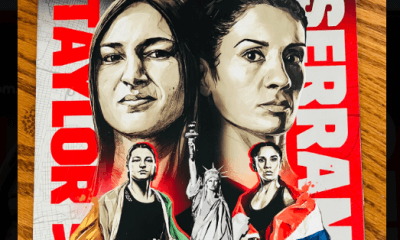Featured Articles
Greg Haugen (1960-2025) was Tougher than the Toughest Tijuana Taxi Driver

Many years ago, this reporter overhead ring announcer Chuck Hull gushing over a young boxer who was fairly new to the professional game. “This kid,” he said, referencing Greg Haugen, “is another Gene Fullmer.”
Hull, who would be inducted posthumously into the International Boxing Hall of Fame, was very familiar with Fullmer, a boxer he greatly admired. The ring announcer had worked two of Fullmer’s title fights, Gene’s 15-round decision over Sugar Ray Robinson in March of 1961 and his 10th-round stoppage of Benny “Kid” Paret later that year.
There was a stylistic similarity between Haugen and Fullmer, but the comparison went beyond that. When the cognoscenti in New York got their first look at Gene Fullmer, they dismissed him as just another good club fighter. It was preposterous to think that one day he would defeat the great Sugar Ray Robinson, and never mind that Sugar Ray’s best days were behind him. (Fullmer and Robinson fought three times. The middle fight was a 15-round draw. Robinson won the first encounter with a vicious one-punch knockout.)
Likewise, even after recording three consecutive upsets in 10-rounders at the Showboat in Las Vegas, Greg Haugen was considered nothing more than a good club fighter. He had a wealth of grit, one could see, but in the eyes of the so-called experts, he was too one-dimensional. It was far-fetched to think that one day he would defeat an opponent as slick as Hector Camacho, but we are getting ahead of ourselves.
Greg Haugen, who passed away last Saturday (Feb. 22) at age 64 in a Seattle-area hospice after a three-year battle with renal cancer, entered the pro ranks after winning Tough Man competitions in Alaska. A native of Auburn, Washington, his first documented fight was in Anchorage. Each of his first five fights was slated for 10 rounds.
Those three upsets were forged against Freddie Roach, Chris Calvin, and Charlie “White Lightning” Brown. Two more fights at the Showboat would follow preceding a date with IBF 135-pound champion Jimmy Paul at the Caesars Palace Sports Pavilion. A protégé of Emanuel Steward, Paul was a product of Detroit’s fabled Kronk Gym.
Haugen was one of the first boxers to cultivate a cult following on ESPN. This owed partly to his attractive young wife and their two daughters, adorable little girls, who appeared on camera a lot as they cheered him on from their ringside seats. That marriage was crumbling when Haugen caught up with Jimmy Paul, but Greg overcame the distraction and captured the title with a hard-earned, 15-round majority decision. According to an Associated Press report, Haugen supplemented his $50,000 purse by getting a $2,000 advance and betting on himself at 4/1 odds.
Haugen lost the title and suffered his first defeat in his first title defense, a 15-rounder with Vinny Pazienza before a rabid pro-Pazienza crowd in Providence, Rhode Island. The “Pazmanian Devil” won five of the last six rounds on all three scorecards to win a unanimous decision, but ended the battle with his face all marked-up. “Many ringside observers, including the majority of out-of-town press, had Haugen the winner,” wrote Boston Globe boxing columnist Ron Borges.
They fought twice more. Haugen recaptured the belt with a wide 15-round decision in the rematch in Atlantic City and Pazienza emerged victorious in the rubber match, winning a 10-round decision. It was a great rivalry. Aggregating the scorecards after 40 bruising rounds, Haugen nipped it 1141-1136.
Between his second and third meetings with Pazienza, Haugen was outclassed by defensive wizard Pernell Whitaker on Whitaker’s turf in Virginia, but Greg’s days as a world title-holder were not over yet.
On Feb. 23, 1991, fighting at 140 pounds, his more natural weight, Haugen became the first man to defeat Hector Camacho, scoring a split decision over the 38-0 Bronx Puerto Rican who was defending his WBO belt. The match at Caesars Palace would have ended in a draw if not for the fact that referee Carlos Padilla docked Camacho a point for refusing to touch gloves at the start of the final round.
For Haugen, a noted spoiler, it was the biggest upset of his career. In the sports books around town, Camacho was as high as a 10-1 favorite.
The rematch in Reno followed a similar tack; it was a very close fight, but Camacho won a split decision and Haugen’s third world title reign, like his first, ended in his first defense.
Haugen returned to Reno the next year where he ended the career of Ray “Boom Boom” Mancini, stopping the former lightweight title-holder and future Hall of Famer in the seventh frame. And then, after defeating two fourth-rate opponents, he was thrust into the fight for which he is best remembered.
Greg Haugen vs. Julio Cesar Chavez at Mexico City’s Azteca Stadium wasn’t a great fight, but it was a great spectacle. The announced attendance, 132,247, broke the record set in 1926 when 120,557 jammed Philadelphia’s Sesquicentennial Stadium for the first meeting between Jack Dempsey and Gene Tunney.
Those that were there will never forget it. Ring announcer Jimmy Lennon Jr recalled that there were little fires up in the far reaches of the mammoth stadium where people were cooking the food they had brought. “I remember thinking that this was more of a mass celebration than just a sporting event,” reminisced Lennon Jr who compared the event to Woodstock in a conversation with Bernard Fernandez for a story that ran on these pages.
Haugen goosed the gate by saying that Chavez had built his record, reportedly 84-0, on the backs of “Tijuana taxi drivers that my mom could whip.” Chavez took it personally and, to the great jubilation of the great multitude, he punished the American before taking him out in the fifth round.
Other boxers since then, lacking Haugen’s originality, have also demeaned their opponent’s conglomeration of former opponents as a bunch of Tijuana taxi drivers. The term seems to have supplanted “tomato cans” as a term of derision. So, Greg Haugen’s legacy extends beyond what he accomplished in the ring. He left an acorn in the storehouse of American slang.
After being manhandled by Julio Cesar Chavez, Haugen sheepishly said, “They must have been very tough taxi drivers.” He would have 15 more fights before leaving the sport in 1999 with a record of 39-10-2 with 19 KOs. In retirement, he trained a few boxers but couldn’t keep at it after suffering nerve damage in his left arm working the pads with a heavyweight.
There were undoubtedly some very tough guys in the ranks of Tijuana taxi drivers, but in a conventional boxing match, Greg Haugen would have likely whipped them all. He was nowhere as great as the stupefyingly sappy post-mortem tribute that ran in a small Washington paper, but he was tough as nails.
Greg Haugen is survived by four children – two daughters and two sons — and five grandchildren. Speaking to Kevin Iole, his daughter Cassandra Haugen said, “He was a good man with a huge heart. He came from nowhere and made himself into a champion, but he was always a kind-hearted man and just the best Dad.”
We here at TSS send our condolences to his loved ones. May he rest in peace.
To comment on this story in the Fight Forum CLICK HERE
-

 Featured Articles4 weeks ago
Featured Articles4 weeks agoAvila Perspective, Chap. 330: Matchroom in New York plus the Latest on Canelo-Crawford
-

 Featured Articles3 weeks ago
Featured Articles3 weeks agoVito Mielnicki Jr Whitewashes Kamil Gardzielik Before the Home Folks in Newark
-

 Featured Articles1 day ago
Featured Articles1 day agoResults and Recaps from New York Where Taylor Edged Serrano Once Again
-

 Featured Articles6 days ago
Featured Articles6 days agoFrom a Sympathetic Figure to a Pariah: The Travails of Julio Cesar Chavez Jr
-

 Featured Articles4 weeks ago
Featured Articles4 weeks agoCatching Up with Clay Moyle Who Talks About His Massive Collection of Boxing Books
-

 Featured Articles1 week ago
Featured Articles1 week agoCatterall vs Eubank Ends Prematurely; Catterall Wins a Technical Decision
-

 Featured Articles3 weeks ago
Featured Articles3 weeks agoMore Medals for Hawaii’s Patricio Family at the USA Boxing Summer Festival
-

 Featured Articles4 weeks ago
Featured Articles4 weeks agoRichardson Hitchins Batters and Stops George Kambosos at Madison Square Garden





















